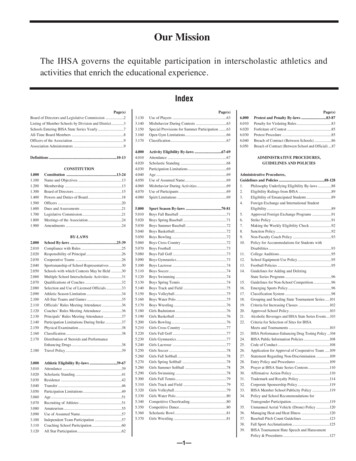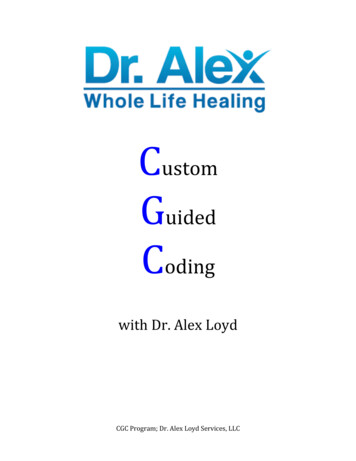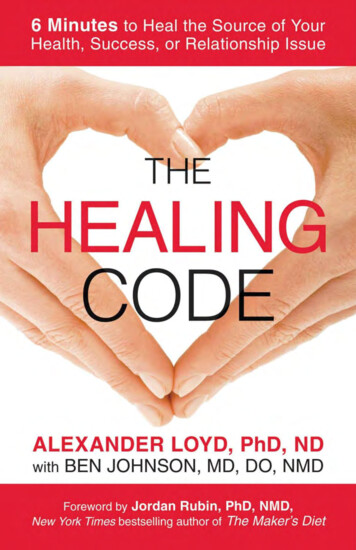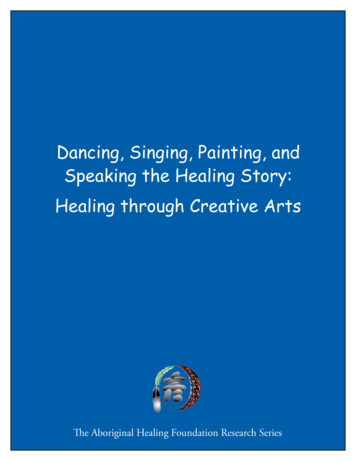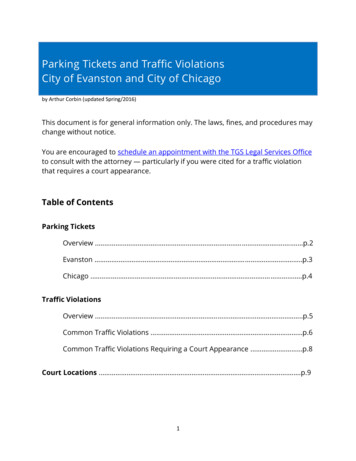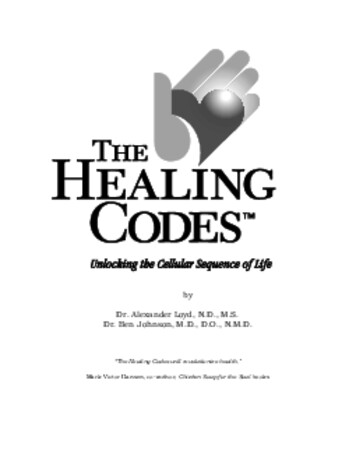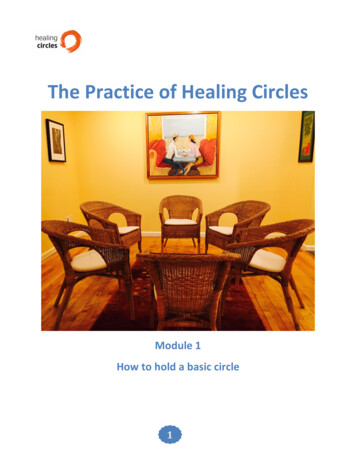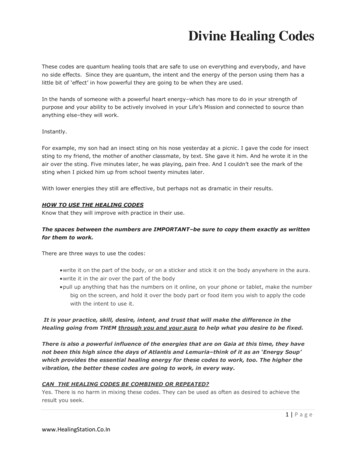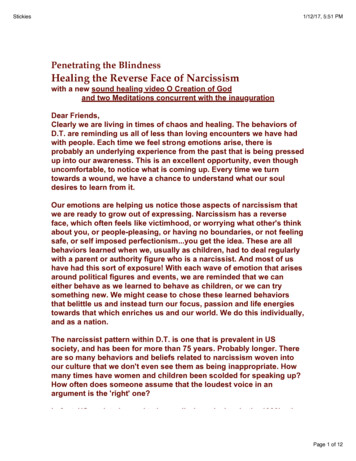
Transcription
HEALING HURTPEOPLE-CHICAGOCASE STUDYJohn H. Stroger, Jr. Hospital of Cook Countyand The University of Chicago MedicineComer Children’s Hospital Chicago, ILIn August 2013, John H. Stroger, Jr. Hospital of Cook County (left) collaborated with The University of Chicago Medicine ComerChildren’s Hospital and the Center for Nonviolence and Social Justice at Drexel University in Philadelphia to launch Healing HurtPeople-Chicago (HHP-C), a hospital-based violence intervention program.Healing Hurt People-Chicago seeks to savelives by offering support beyond the hospitalOverviewChicago saw a spike in violent crime duringthe past few years, with an all-time high of771 homicides and 3,550 shootings occurring in 2016. In 2017, those rates decreased, but at650 homicides and 2,785 shootings, the city stillexceeded the number of killings in New York Cityand Los Angeles combined. In addition, a highpercentage of those violent crimes took place onChicago’s West Side, where John H. Stroger, Jr.Hospital of Cook County is located.In August 2013, Stroger Hospital collaborated withThe University of Chicago Medicine Comer Children’s 2018 American Hospital AssociationHospital and the Center for Nonviolence and SocialJustice at Drexel University in Philadelphia to launchHealing Hurt People-Chicago (HHP-C), a hospital-based violence intervention program. Throughassessment, psycho-education, intensive casemanagement, group therapy and mentoring, HHP-Chelps youth who have been violently injured healboth physically and emotionally.“We try to identify patients as early as possible,”says Bradley Stolbach, Ph.D., associate professorof pediatrics at University of Chicago Medicineand co-principal investigator and clinical director forHHP-C. “We want to make contact with them assoon as they’ve been identified as having suffered awww.aha.org February 2018
violent injury, while they’re still at Comer or Stroger,members and helping them obtain access towhether they are admitted or not.”services as well. Trauma intervention specialists canIn the initial contact, a trauma interventionhelp them navigate those various systems and advospecialist or other HHP-C staff member provides thecate for themselves.patient with basic psychoeducation about trauma“Sometimes they need us to advocate for themand how to cope with it. They discuss the responseas well,” Stolbach says. “In a lot of these systems, ifthat the patient might be feeling and strategies forour patients didn’t have someone next to them withmanaging reactions.light skin and an advanced degree, they wouldn’t beThe staff member will also then talk to the patientheard at all.”and their family about HHP-C’songoing services that are available. Ifthe patient is interested, they are putin touch with a trauma interventionspecialist who will be their main pointof contact throughout their HHP-Cexperience.“Our people work with them toassess what is happening in thepatient’s life – what they’ve beenthrough during this injury and in thepast, what symptoms they’re experiencing, their psychosocial needs, theirneeds in their daily lives, and theirgoals,” Stolbach says. “Their goalsoften have to do with education, jobs,Bradley Stolbach, Ph.D., associate professor of pediatrics, University ofmedical care, family issues, housingChicago Medicine; co-principal investigator and clinical director, Healingor the court system. “We find outHurt People-Chicagowhat they want and help them getthere – they’re their goals, not ours.”“What happens in the hospitalis engagement and gainingtheir trust. The work of thetrauma intervention specialistsis almost all outside thehospital – in the community,in patients’ homes, going to court or medicalappointments with people, trying to havecontact with every patient at least weekly.”SELF groupsStaying safeOne of the ways they do this is through psychoeducational groups, known as SELF (Safety, Emotions,Loss, and Future) groups. Whether in the individualcontext or within groups, HHP-C staff work to facilitate conversations about those four domains.“When you’re dealing with trauma and violence,you often have struggle,” Stolbach says. “Most ofour work occurs after discharge – what happens inthe hospital is engagement and gaining their trust.The work of the trauma intervention specialists isalmost all outside the hospital – in the community, inpatients’ homes, going to court or medical appointments with people, trying to have contact with everypatient at least weekly, ideally face to face.”This work may also include working with familyMany of the HHP-C participants were injured in theirown neighborhoods, so after discharge, they returnto that environment and its risks.“A lot of our work is helping patients identifyhow to keep themselves safe in that environment,”says Rev. Carol Reese, LCSW, violence prevention coordinator and chaplain for the Departmentof Trauma/Burns at John H. Stroger, Jr. Hospitalof Cook County and co-principal investigator andprogram director for HHP-C. “They might havetrouble getting from home to school safely. Theymight have to go past the place where they wereshot to get to school or work. Sometimes there’san ongoing dispute between the patient and theperson who hurt them, and the worry is that 2018 American Hospital Associationwww.aha.org February 2018 2
they’re going to do something unsafe, like retaliation. We don’t want to see these kids back withanother injury. All parts of the SELF model areimportant, but we spend a lot of time on emotionsand emotional self-regulation.”Reese notes that many young people who live inunsafe conditions are chronically activated, particularly if they have suffered a violent injury.“They’re constantly on guard and waiting forsomething bad to happen, then something minorhappens and they engage before they stop to thinkabout it,” she explains. “We give them strategies formanaging their reactions before they do somethingthey will regret for a long time.”of Chicago Medicine Recovery and EmpowermentAfter Community Trauma Program (REACT). REACTworks in conjunction with HHP-C, serving patientsand families affected by community violence whetherthey were injured or not. The program is linked tothe Comer emergency department and pediatricintensive care unit. In addition, the program conductsoutreach on Comer’s Pediatric mobile medical unit, aswell as brief trauma intervention and ongoing psychotherapy for those who need it.Another related program is Project FIRE (FearlessInitiative for Recovery and Empowerment), an artistdevelopment employment program that offershealing through glassblowing, combining glass artseducation, mentoring, andtrauma psychoeducation tosupport trauma recovery andcreate jobs for youth injuredby violence. Co-created byglass artist Pearl Dick andStolbach with the support of aUniversity of Chicago MedicineUrban Health Initiative FacultyFellowship, Project FIRE is apartnership of HHP-C, FirehouseGlass Studio, and ArtReachChicago. As a result of thesuccess of Project FIRE, HHP-Cis looking to create similarRev. Carol Reese, LCSW, violence prevention coordinator and chaplain for theprograms in other arts disciDepartment of Trauma/Burns, John H. Stroger, Jr. Hospital of Cook County;plines, such as improv.co-principal investigator and program director, Healing Hurt People-ChicagoThe University of Chicagoalso hosts the Center for YouthViolence Prevention, one of theThe Healing Hurt People model was develCDC’s six National Centers of Excellence in Youthoped over a decade ago at the Drexel Center forViolence Prevention. This program is not a part ofNonviolence and Social Justice under the directionHHP-C, as it does not offer patient services, butof John Rich, M.D., Ted Corbin, M.D., and Sandrait conducts research to help programs like HHP-CBloom, M.D., and is also being implemented in fivedetermine the best methods for serving its patients.Level 1 Trauma Centers in Philadelphia.“Most of our patients have also lost friends, familymembers and close associates due to communityAdditional programsviolence, so this is with them all the time,” ReeseIn September 2016, Dr. Stolbach received a grant tosays. “We need to help them integrate the conceptsallow The University of Chicago Comer Children’sof violence prevention into their lives and plan forHospital to offer screening and mental health caretheir future. We want them to be able to envisionfor patients and their families through the Universitysomething good for themselves down the road.”“Most of our patients have alsolost friends, family membersand close associates due tocommunity violence, so this is withthem all the time. We need to helpthem integrate the concepts ofviolence prevention into their lives and plan fortheir future. We want them to be able to envisionsomething good for themselves down the road.” 2018 American Hospital Associationwww.aha.org February 2018 3
ImpactHHP-C tracks a variety of outcome indicators,including rates of reinjury, retaliation, andinvolvement in the criminal justice system.Based on reports from the trauma interventionspecialists and their clients, approximately 90 percentof the patients who have worked with HHP-C forsix months or longer have avoided reinjury, havenot been involved in retaliation, and have not beencharged with crimes.Other indicators they watch for include increasedservice utilization, decreased post-traumatic stressdisorder (PTSD) symptoms, and decreasedsubstance use.“Substance use is thetoughest to make a dentof patients who have in,” Stolbach says. “About60 percent of our patientsworked with HHP-Cshow reduced substancefor six months oruse, which is good, butlonger have avoided not as good as our PTSDreinjury, have notand service utilizationnumbers, which arebeen involved inretaliation, and have around 80 percent. We’recontinually looking intonot been chargedways to make more progwith crimes.ress in helping reducesubstance use further.”Meanwhile, a numberof HHP-C participants have moved into the rolesof group leaders or co-facilitators in the program,whether with HHP-C or Project FIRE.“They’re focused not just on their own recoverybut also on spreading the recovery to others,”Stolbach says.90%Cost containmentReese notes that while cost-benefit analyses don’talways move organizations to get involved in programssuch as this, there is definitely a financial advantage.“The cost of caring for a patient through HHP-Cfor a few months to a few years is 3,500 to 5,000,”she says. “That’s significantly less than what itwould cost for repeated injury treatment. This type of 2018 American Hospital Associationintensive service is also about one-tenth the cost ofanother hospital admission or long-term therapy.”Research on hospital-based violence intervention programs has shown that in a worst-case costscenario, they may cost as much as the usual care.However, when compared with other, less intensiveintervention, they’re more effective.“Simulations showed that the savings over timeare anywhere from thousands to millions of dollars,”Stolbach says.Of course, much of the impact of HHP-C cannotbe measured with data.“What we see in these kids is that we can havea positive impact on their physical and emotionalhealing,” Reese says. “Maybe they’re coming up inhomes where parents aren’t engaged, or the familymay be impoverished. One trauma interventionspecialist went to the home of a kid with a spinalcord injury, and she found him trying to get out of thehouse by himself in the dark. Also, she found thatthere was no food in the house. Many patients havevery basic needs like this: If you don’t have food in thehouse, and you don’t have anyone who can help youaround, you’re not going to be able to heal from aninjury. Our resources promote healing and keep youngpeople from re-engaging with the health care system.We can help them avoid the ‘revolving door.’”Lessons Learned“One of the big things we’ve learned is thatsafety plays a major role not only for ourpatients and their families, but for ourfront-line workers, whether peer workers or licensedclinical social workers,” Reese says. “Early on, we didnot pay adequate or intensive enough attention tothe negative impact that safety issues were havingon our staff. Because they’re going out into communities to work with patients, they’re also witnessingviolence and feeling unsafe. There’s also somesecondary trauma that comes from hearing aboutthe violence that our patients have experienced. Wehad a few staff resign, and safety was part of theirreasoning to move on.”Therefore, HHP-C leaders have been reworkingpolicies and procedures to give staff some strategieswww.aha.org February 2018 4
to stay safer. For example, when going to the firsthome visit with a new patient, staff must attend inpairs; previously, it was presented as an option, butnow it is a requirement. Additionally, staff now haveapps on their phones that include “panic buttons,”which notify Reese, Stolbach, and other trauma intervention specialists if they’re in an unsafe situation.The organization is also working to find other,safer spaces where meetings can take place, such asschools or churches.“Staff may be fearful about spending timein some of these neighborhoods, and then weremember that our patients and their families livethere all the time,” Stolbach says.Future GoalsCurrently, HHP-C’s “biggest hope” is to expandthe age groups served, Reese says.“We’re very focused on serving olderadolescents and young adults, ages 18 and younger,”she explains. “But the vast majority of people injuredwith penetrating trauma are young adults, ages 18 to26 or 27. We’re working with a few organizations totry and secure funding to expand to that population.”Another goal for HHP-C’s near future is building amore robust mental health response.“The clinicians we work with are very good, butwe need even more resources,” Reese says. “We’reworking to connect with a behavioral health consortium convened by Cook County Health to expand ourresources. The REACT program is one part of that.” 2018 American Hospital AssociationIn the longer term, Reese and Stolbach wouldlike to partner with some of Chicago’s many level1 trauma centers to provide this type of support tomore children and young adults who are violentlyinjured.Meanwhile, they would like to be able to offermore jobs and more hours to the young people whohave been successful in the program.“We want them to know how much we valuetheir time and expertise,” Reese says.CONTACTBradley C. Stolbach, Ph.D.Clinical Director and Co-Principal Investigator,The University of Chicago Medicine ComerChildren’s uCONTACTRev. Carol S. Reese, LCSWProgram Director and Co-Principal Investigator,John H. Stroger, Jr. Hospital of Cook org February 2018 5
Healing Hurt People-Chicago (HHP-C), a hospi-tal-based violence intervention program. Through assessment, psycho-education, intensive case management, group therapy and mentoring, HHP-C helps youth who have been violently injured heal both physically and emotionally. "We try to identify patients as early as possible,"
